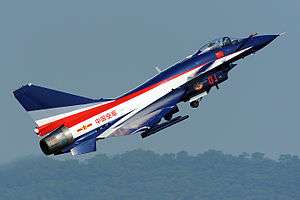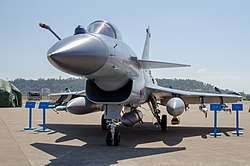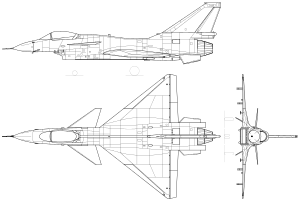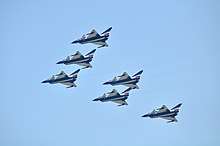Chengdu J-10
The Chengdu J-10 (simplified Chinese: 歼-10; traditional Chinese: 殲-10; NATO reporting name: Firebird,[6] also known as Vigorous Dragon (Chinese: 猛龙; pinyin: Měnglóng),[7][8] is a single-engine, lightweight multirole fighter aircraft capable of all-weather operation, configured with a delta wing and canard design,[9] with fly-by-wire flight controls, and produced by the Chengdu Aircraft Corporation (CAC) for the People's Liberation Army Air Force (PLAAF).
| J-10 Vigorous Dragon F-10 Vanguard | |
|---|---|
 | |
| Role | Multirole combat aircraft |
| National origin | China |
| Manufacturer | Chengdu Aircraft Industry Group |
| Design group | Chengdu Aircraft Design Institute |
| First flight | 23 March 1998[1] |
| Introduction | 2006[2] |
| Status | In service |
| Primary user | People's Liberation Army Air Force |
| Produced | 2002 – present[3] |
| Number built | 468 as of 2020[4] |
| Program cost | 500 million RMB allocated in 1982[1] (Project #10) |
| Unit cost | |
Development history
The program was authorized by Deng Xiaoping in the 1980s who allocated ¥ 0.5 billion to develop an indigenous aircraft. Work on Project #10[1] started several years later in January 1988,[10] as a response to the Mikoyan MiG-29 and Sukhoi Su-27 then being introduced by the USSR, and F-15, F-16 already in service in the United States. Development was delegated to the 611 Institute, also known as the Chengdu Aircraft Design Institute and Song Wencong was nominated as the chief designer, as he had previously been the chief designer of the J-7III. The aircraft was initially designed as a specialized fighter, but later became a multirole aircraft capable of both air-to-air combat and ground attack missions.
In 2006, the Russian Siberian Aeronautical Research Institute (SibNIA) confirmed its participation in the J-10 program; SibNIA claimed to have only observed and instructed as "scientific guides", while its engineers also believed the J-10 was "more or less a version" of the IAI Lavi, incorporating "a melting pot of foreign technology and acquired design methods".[11][12]
The J-10 was officially unveiled by the Chinese government in January 2007, when photographs were published by Xinhua News Agency. The aircraft's existence was known long before the announcement, although concrete details remained scarce due to secrecy. Rumors of crashes during flight testing were actually mishaps related to the AL-31 engine.[13]
The first prototype "J-10 01" was rolled out in November 1997 and first flown on 23 March 1998[1][14] in a twenty-minute flight.
AVIC plans to market an upgraded J-10 for export, most likely the J-10B, once development is complete. Several countries have shown interest.[15]
In 2015, China Military Online published an analysis advocating Argentina's adoption of the J-10, claiming that while the operational range of current versions could not yet allow it to reach the Falkland Islands, the aircraft, particularly its radar, were superior to the Typhoon and that tanker aircraft could place the islands within range. China has been promoting the J-10 to the Argentine republic and during a February 2015 visit to China by President Kirchner established a joint fighter aircraft working group.[16]
Design
J-10 was designed and developed by the Chengdu Aircraft Design Institute (CADI), a subsidiary of Chengdu Aircraft Corporation.
Airframe
The airframe is constructed from metal alloys and composite materials for high strength and low weight, the airframe's aerodynamic layout adopts a "tail-less canard delta" wing configuration. A large delta wing is mid-mounted towards the rear of the fuselage, while a pair of canards (or foreplanes) are mounted higher up and towards the front of the fuselage, behind and below the cockpit. This configuration provides very high agility, especially at low speeds, and also reduces stall speed, allowing for a lower airspeed during instrument approaches. A large vertical tail is present on top of the fuselage and small ventral fins underneath the fuselage provide further stability.
A rectangular air intake ramp and a Splitter plate (only on J-10A) are located underneath the fuselage, providing the air supply to the engine. Newer variants use a diverterless intake that does not require a splitter plate, and may reduce radar cross signature. Also under the fuselage and wings are 11 hardpoints, used for carrying various types of weaponry and drop-tanks containing extra fuel.
The retractable undercarriage comprises a steerable pair of nose-wheels underneath the air intake and two main gear wheels towards the rear of the fuselage.

The cockpit is covered by a two-piece bubble canopy providing 360 degrees of visual coverage for the pilot. The canopy lifts upwards to permit cockpit entry and exit. The Controls take the form of a conventional centre stick and a throttle stick located to the left of the pilot. These also incorporate "hands on throttle and stick" (HOTAS) controls. A zero-zero ejection seat is provided for the pilot, permitting safe ejection in an emergency even at zero altitude and zero speed.
Due to the J-10's aerodynamically unstable design, a digital quadruplex-redundant fly-by-wire (FBW) flight control system (FCS) aids the pilot in flying the aircraft. The FCS typically monitors pilot control inputs, preventing the pilot from accidentally exiting the flight envelope from applying too much control input during high performance flight situations. This is critical in canard wing aircraft, as they are capable of turning in a much tighter radius than conventional aircraft. The massive control surfaces are capable of moving so far that they can completely destroy the aircraft in flight at high airspeeds if not kept in check by the FCS.
Avionics
The cockpit has three liquid crystal (LCD) Multi-function displays (MFD) along with a Chinese developed holographic head-up display (HUD), all of which are fully compatible with a domestic Chinese advanced helmet mounted sight (HMS), claimed by Chinese to be superior to the HMS on the Sukhoi Su-27 sold to China.[17][18]
Radar
According to Chengdu Aircraft Industry Corporation officials the J-10 uses a multi-mode fire-control radar designed in China. The radar has a mechanically scanned planar array antenna and is capable of tracking 10 targets. Of the 10 targets tracked, 2 can be engaged simultaneously with semi-active radar homing missiles or 4 can be engaged with active radar homing missiles.[19]
For J-10B, the nose cone is modified to accommodate an active phased array airborne radar (AESA) radar.[20][21] The general designer of AESA for J-10B is Mr. Zhang Kunhui (张昆辉, 1963 -), the head of 607 Research Institute in Neijiang, Sichuan. Mr. Zhang Kunhui became the deputy head of 607th Research Institute in 1997, and four years later in 2001, he became the head of the institute, when the AESA program for J-10B started. The primary contractor of this AESA is the Radar and Electronic Equipment Research Academy of Aviation Industry Corporation of China located in Sichuan, formed in March 2004 by combining the 607th Research Institute and 171st Factory together with Mr. Zhang Kunhui was named as the head of the research academy. According to Chinese governmental media, the AESA for J-10B took 8 years to develop, finally completed in 2008, and Chinese fighter radars hence achieved a quantum leap in that it went from mechanically scanned planar slotted array directly into AESA, skipping the passive phased array PESA radar.[22] Many suspected the radar is a PESA, but during its brief debuts in the 7th China International Defense Electronics Exhibition (CIDEX) in May 2010 and the 6th International Conference on Radar held in Beijing in Sept 2011, Chinese official sources have claimed it is an AESA.[23]
Propulsion

The J-10A is powered by a single Russian Lyulka-Saturn AL-31FN turbofan engine giving a maximum static thrust of 12,500 kgf (123 kN).[24] The AL-31FN is based on the AL-31F which was designed for a twin engine aircraft such as the Su-27, to fit the smaller J-10 the engine parts have been moved and re-designed to fit the smaller engine bay in the J-10.
The J-10 was intended to be powered by the Chinese WS-10 Taihang turbofan, but development difficulties forced the J-10A to use a Russian engine instead.[25] Future J-10 will likely be equipped with an improved WS-10 type engine designed specifically for it, as the Chinese aeroengine industry matures and political/military pressure to indigenize increases.[26]
In April 2014, China have entered into a contract with NPO Saturn to purchase the upgraded AL-31FN Series 3 that provides 13,700 kgf thrust and a 2,250-hour service life for future deliveries. Prior, the AL-31FN Series 3 had accumulated 750 hours of test operation on the J-10 aircraft in a test programme.[27]
In Jan 2018, an image has emerged on Chinese online forums showing a Chengdu Aircraft Industries Company J-10 multirole fighter aircraft powered by what may be an engine featuring a thrust vector control (TVC) nozzle.[28] Newer aircraft also use a diverterless intake, a design intended to reduce complexity and often reduces radar cross signature as well.
In November 2018, a J-10B powered by WS-10 thrust vector control (TVC) publicly displayed at the Zhuhai AirShow and made a Pugachev's Cobra action.[29]
Weaponry and external loads
The aircraft's internal armament consists of a Gryazev-Shipunov GSh-23 twin-barrel cannon, located underneath the port side of the intake. Other weaponry and equipment is mounted externally on 11 hardpoints, to which 6,000 kg (13,228 lb)[30] of either missiles and bombs, drop-tanks containing fuel, or other equipment such as avionics pods can be attached.
Air-to-air missiles deployed may include short-range air-to-air missiles such as the PL-8 and PL-9, medium-range radar-guided air-to-air missiles such as the PL-11 and PL-12, unguided and precision guided munitions such as laser-guided bombs, anti-ship missiles such as the YJ-9K and anti-radiation missiles such as the PJ-9.
Operational history
China
The first aircraft were delivered to the 13th Test Regiment on 23 February 2003. The aircraft was declared 'operational' in December of the same year, after 18 years in development.[1][31] The first operational regiment was the 131st Regiment of the 44th Division.
The J-10C entered combat service in April 2018.[32]
Potential operators
Pakistan
In February 2006, then-President of Pakistan Pervez Musharraf, toured the J-10 and JF-17 production facilities on a trip to China during which the Pakistan Air Force (PAF) was offered the J-10,[33][34] and the purchase of 36 FC-20s, a Pakistan-specific J-10B variant, was approved in April 2006.[34] In November 2009, Pakistan signed a deal with China to buy 36 J-10B fighters in a deal worth around $1.4 billion.[35][36]
In July 2011, Daily Jang reported that China will give a squadron of the advanced J-10B fighter aircraft to Pakistan. According to the report, "the offer was made by senior Chinese military leaders to visiting Pakistan Army's Chief of General Staff, Lt Gen Waheed Arshad".[37][38] In March 2012, talks were held between the two countries to discuss the delivery of latest J-10B fighter jets to Pakistan. However, this has been cancelled as of 2016. Pakistan Air Force is focussing on JF-17 Block 3 and in future it is looking to procure the export version of J-31, the FC-31 stealth fighter. 40 jets are to be procured initially.[39]
Controversy
The J-10 is externally similar to the IAI Lavi. In 2008, aviation publishing house Jane's alleged that China's development of the Chengdu J-10 had benefited from technical information from the Lavi project, citing senior Russian engineers who said they had heard this from Chinese colleagues.[40] In 2007, the J-10's designer, Song Wencong (宋文骢), denied any connection with the Lavi, pointing to similarities with the Chengdu J-9, which developed in the 1960s.[41] This was echoed by PLAAF major Zhang Weigang in a 2012 interview.[42] There have been no public statements or formal claims along those lines; by 2000, however, openly disclosed advanced technology transfer of any origin had become anathema to the United States,[43] which forced Israel to cancel a sale of Phalcon airborne early warning planes.
Variants
_(5).jpg)
- J-10A: Single seat multi-role variant. The export designation is F-10A.[44]
- J-10S: Tandem-seated trainer variant of J-10A.[45]
- J-10B: An upgraded J-10, initially identified as "Super-10".[46] It features a lighter and stealthier diverterless supersonic inlet, a longer nose radome possibly housing an active electronically scanned array radar, an electro-optic targeting sensor (IRST, and laser rangefinder,) and a new electronic warning or countermeasures pod atop the vertical stabiliser.[47] The aircraft is powered by the AL-31FN M1;[47] one unit was flown with a WS-10A in July 2011 but that engine was not selected for the initial production batch.[48] The aircraft's first flight occurred no later than December 2008.[49]
- J-10C: An upgraded version of J-10B, it is equipped with an indigenous Active electronically scanned array (AESA) fire-control radar and is equipped with infrared-homing PL-10 and new long range PL-15 air-to-air missile (AAM).[50][51]
- FC-20: Single seat multi-role fighter jet, the export version of the J-10.[52]
- J-10B TVC Demonstrator: A prototype fighter based on J-10B that is equipped with WS-10B thrust-vectoring control engine. The fighter has supermaneuverability, capable of performing Pugachev's Cobra.[53]
Operators
- People's Liberation Army Air Force: 78 J-10, 142 J-10A, 55+ J-10B, 48 J-10S As of February 2017[54]
- People's Liberation Army Naval Air Force: 16 J-10A, 7 J-10S As of 2017[55]
Accidents and incidents
On 13 November 2016, the first J-10 female pilot, Captain Yu Xu, was killed in an aerobatics display in Hebei province while performing with the August 1st Aerobatics Team.[56]
Specifications (J-10A)


Data from
General characteristics
- Crew: 1[31]
- Length: 16.43 m (53 ft 11 in)
- Wingspan: 9.75 m (32 ft 0 in)
- Height: 5.43 m (17 ft 10 in)
- Wing area: 33 m2 (360 sq ft)
- Empty weight: 9,750 kg (21,495 lb) [57]
- Gross weight: 12,400 kg (27,337 lb)
- Max takeoff weight: 19,277 kg (42,499 lb) [31][57]
- Powerplant: 1 × Saturn-Lyulka AL-31FN afterburning turbofan engines, 79.43 kN (17,860 lbf) thrust (or WS-10A) dry, 125 kN (28,000 lbf) with afterburner
Performance
- Range: 3,200 km (2,000 mi, 1,700 nmi) [58][57]
- Combat range: 1,250 km (780 mi, 670 nmi) [58][57]
- Maximum speed: Mach 2.2[58][59]
- Service ceiling: 18,000 m (59,000 ft) [57]
- g limits: +9 –3[57]
- Wing loading: 381 kg/m2 (78 lb/sq ft)
- Thrust/weight: 1.15 (with Saturn AL-31FN3); 1.16 (with WS-10A)
- Instantaneous Turn Rate: 31+ degrees per second
- Roll Rate: 300+ degrees per second
Armament
- Guns: 1× Gryazev-Shipunov GSh-23
- Hardpoints: 11 in total (6× under-wing, 2× under-intake and 3× under-fuselage) with a capacity of 7,000 kg (15,400 lb) external fuel and ordnance[30],
- Rockets: 90 mm unguided rocket pods
- Missiles:
- Air-to-air missiles:
PL-8
PL-9
PL-10
PL-11
PL-12
PL-15 - Air-to-surface missiles:
PJ-9
YJ-9K
- Air-to-air missiles:
- Bombs:
Laser-guided bombs: (LT-2)
Glide bombs: (LS-6, GB3, GB2A, GB3A)
Satellite-guided bombs: (FT-1)
Unguided bombs: 250 kg, 500 kg - Others:
- Up to 3 external fuel drop-tanks (1× under-fuselage, 2× under-wing) for extended range and loitering time
Avionics
- Type 1473H pulse-doppler fire control radar
- Externally mounted avionics pods:
- Type Hongguang-I infra-red search and track pod
- BM/KG300G self-protection jamming pod
- KZ900 electronic reconnaissance pod
- Blue Sky navigation/attack pod
- FILAT (Forward-looking Infra-red Laser Attack Targeting) pod
See also
Related development
Aircraft of comparable role, configuration and era
- General Dynamics F-16 Fighting Falcon
- Boeing F/A-18E/F Super Hornet
- Dassault Rafale
- Eurofighter Typhoon
- Mikoyan MiG-35
Related lists
References
- Wang Jieqing. "J-10 Fighter Test Flight Process Secret Revealed". Southern Weekend. Archived from the original on 21 March 2007. Retrieved 4 January 2007.
- "中国自行研制的歼-10战机正式列装我军航空兵" (in Chinese). Xinhua News Agency. 29 December 2006. Archived from the original on 25 April 2011. Retrieved 5 January 2012.
- "Chengdu J-10 (Jian-10, Fighter aircraft-10 / F-10)". globalsecurity.org. Archived from the original on 18 October 2007. Retrieved 23 October 2007.
- Ministry of Defense (Japan), P. 65
- Hornby, Lucy (13 April 2010). "reuters, China J-10". In.reuters.com. Archived from the original on 31 October 2018.
- Gulf Security after 2020 (PDF) (Report). International Institute for Strategic Studies. 19 December 2017. p. 25. Archived (PDF) from the original on 29 April 2018. Retrieved 28 April 2018.
- "J-10 (Jian 10) Vigorous Dragon Multirole Tactical Fighter". Airforce Technology. Archived from the original on 27 October 2018. Retrieved 12 March 2019.
- "Chengdu (AVIC) J-10 (Vigorous Dragon) / F-10 Vanguard". Military Factory. Archived from the original on 14 June 2017. Retrieved 12 March 2019.
- "Archived copy". Archived from the original on 5 July 2008. Retrieved 24 October 2015.CS1 maint: archived copy as title (link)
- John Pike (28 June 2002). "Chinese Aircraft – J-10". Globalsecurity.org. Archived from the original on 18 October 2007.
- "SibNIA remains center of Russian innovation". 2007. Archived from the original on 1 February 2014. Retrieved 20 January 2014.
- Hollings, Alex (19 September 2018). "Counterfeit Air Power: Meet China's Copycat Air Force". Popular Mechanics. Archived from the original on 28 January 2019. Retrieved 27 January 2019.
- Rupprecht, Andreas, 2013. Dragon's Wings. Birmingham: Ian Allan Publishing Ltd.
- Zhang Baoxin (1 January 2007). "CAC J-10 External Design Did Not Receive Foreign Assistance". Aerospace World magazine. Archived from the original on 7 July 2011. Retrieved 1 January 2007.
- Siva Govindasamy, "China's AVIC steps up sales push for FC-1, J-10 fighters" Archived 3 October 2009 at the Wayback Machine, Flight International, Retrieved: 2 October 2009
- Tate, Andrew (25 February 2015). "China's J-10 advocated as Argentine 'Typhoon beater'". IHS Jane's Defence Weekly. 52 (8). IHS. p. 5.
- "中国第四代先进战机机头及座舱亮相珠海航展(图)-吊舱,头盔瞄准具,航电系统,凤凰网,凤凰新媒体-黄岩新闻网". Archived from the original on 21 November 2015. Retrieved 4 February 2015.
- sina UI Team. "这个是歼10战机飞行员头盔瞄准具吗?". Archived from the original on 22 November 2015. Retrieved 4 February 2015.
- "Jian-10 (J-10, F-10) Multirole Fighter Aircraft". SinoDefence.com. Archived from the original on 1 March 2010. Retrieved 21 March 2010.
- "歼10B有源相控阵雷达曝光 配置与美军一致(组图)". Archived from the original on 6 February 2015. Retrieved 4 February 2015.
- "网曝中国空军歼10B机载雷达照 与美战机类似引热议". Archived from the original on 6 February 2015. Retrieved 4 February 2015.
- "创新超越促发展--记中航工业雷电院长张昆辉" Archived 8 March 2013 at the Wayback Machine cannews.com.cn 14 January 2013
- "中国歼-10B相控阵雷达首次曝光:达世界先进水平 - 复兴网". Archived from the original on 6 February 2015. Retrieved 4 February 2015.
- "AL-31FN" (in Russian). Salyut. Archived from the original on 8 October 2011. Retrieved 12 January 2013.
- "Liming WS10A Taihang Engine". globalsecurity.org. 11 July 2011. Archived from the original on 22 January 2013.
- Richard, Fisher, Jr. (15 October 2011). "China's Maturing Fighter Force". International Strategy and Assessment Center. Archived from the original on 30 December 2012.
- "Al-31FN Series 3" Archived 9 January 2014 at the Wayback Machine Salut, 24 December 2013.
- "Image suggests China may be testing thrust-vectoring engine on J-10 fighter" Archived 15 April 2018 at the Wayback Machine Jane's 360, 5 January 2018.
- "YouTube". www.youtube.com. Retrieved 1 January 2019.
- "New generation of fighter jets on horizon". Global Times. 10 November 2009. Archived from the original on 19 January 2015. Retrieved 19 January 2015.
- "Sinodefence.com: J-10 Multirole Fighter Aircraft". Archived from the original on 29 March 2007. Retrieved 9 April 2007.
- ZX, ed. (16 April 2018). "China's fighter jet J-10C begins combat duty". Xinhuanet. Archived from the original on 29 April 2018. Retrieved 28 April 2018.
- "Pakistan will stand by China against US 'siege', says Rashid". Daily Times (Pakistan). 23 February 2006. Archived from the original on 3 February 2008. Retrieved 8 September 2013.
- Ansari, Usman (3 August 2011). "China Officially Offers Pakistan J-10 Variant". Defense News. Retrieved 8 September 2013.
- "Pakistan signs deal for Chinese J-10 fighters". Flight International. 13 November 2009. Archived from the original on 9 December 2014. Retrieved 8 September 2013.
- Bokhari, Farhan (10 November 2009). "Pakistan in Chinese fighter jet deal". Financial Times. Retrieved 8 September 2013.
- "China to give squadron of J10-B fighters to Pakistan". Hindustan Times. 30 July 2011. Archived from the original on 31 October 2013. Retrieved 8 September 2013.
- "China to give squadron of J10-B fighters to Pakistan". Greater Kashmir. 31 July 2011. Archived from the original on 24 August 2013. Retrieved 8 September 2013.
- "J-10B fighter planes, 6 marines for Pakistan as Cino-Pak talks underway and lead to pakistan acquiring 100 j-10 and f16 super hornets". The News Tribe. 22 March 2012. Archived from the original on 14 September 2013. Retrieved 10 September 2013.
- Hewson, Robert. "Chinese J-10 'benefited from the Lavi project'". Archived 26 May 2008 at the Wayback Machine Jane's, 19 May 2008.
- "Exclusive Interview with J-10 General Designer Song Wencong". 2007. Archived from the original on 24 January 2009. Retrieved 6 January 2007.
- "少将驳斥"战机抄袭论":歼-10源自于歼-9". 2012. Archived from the original on 27 January 2013.
- Adelman, Jonathan. "The Phalcon Sale to China: The Lessons For Israel". Archived 8 March 2017 at the Wayback Machine Jerusalem Center for Public Affairs, Retrieved 27 September 2007.
- "Pakistan approves purchase of Lockheed Martin F-16s and Chengdu J-10 fighters-13 April 2006-Washington DC-Flight International". Flightglobal.com. 13 April 2006. Archived from the original on 13 December 2009.
- Kopp, Carlo (10 July 2007). "J-10S Dual Seat Variant". Air Power Australia: 1. Archived from the original on 4 August 2018. Retrieved 4 August 2018. Cite journal requires
|journal=(help) - Ivanov, Henry (9 January 2006), China working on "Super-10" advanced fighter, Janes Defence World, archived from the original on 11 January 2006
- Weening, Alexander; Hardy, James (9 October 2014). "New pictures of J-10B revealed". IHS Jane's 360. Archived from the original on 29 April 2015. Retrieved 6 August 2015.
- Fisher, Richard D. Jr. (12 January 2015). "Images suggest J-10Bs close to entering Chinese service". janes.com. Archived from the original on 30 April 2015. Retrieved 25 May 2015.
- "New J-10 Variant sighted". Janes Defence News. 23 March 2009. Archived from the original on 26 March 2009. Retrieved 23 May 2011.
- Chuanren, Chen. "New Chinese Weapons Seen on J-10C Fighter". Aviation International News. Archived from the original on 10 January 2019. Retrieved 1 January 2019.
- "New BVRAAM may have entered PLAAF service". janes.com. Archived from the original on 17 May 2018. Retrieved 1 January 2019.
- Lei, Zhao (18 February 2016). "PLA's fighter jets go up for sale". China Daily. Archived from the original on 19 February 2016. Retrieved 19 February 2016.
- WALDRON, GREG (6 November 2018). "J-10B TVC wows Zhuhai crowds with surprise performance". flightglobal. Archived from the original on 7 November 2018. Retrieved 7 November 2018.
- International Institute for Strategic Studies: The Military Balance 2017, p.284
- International Institute for Strategic Studies: The Military Balance 2017, p.283
- Brad Lendon. "Horrific crash kills Yu Xu, 1st woman to fly China's J-10 fighter". CNN. Archived from the original on 14 November 2016. Retrieved 14 November 2016.
- "J-10 (Jian 10) – Vigorous Dragon Multi-Role Tactical Fighter, China". SPG Media Limited. 10 February 2008. Archived from the original on 13 July 2007.
- "Archived copy". Archived from the original on 18 April 2019. Retrieved 18 April 2019.CS1 maint: archived copy as title (link)
- Ministry of Defense of Japan (2017). Defense of Japan 2017 (PDF) (Report). p. 95. Archived (PDF) from the original on 29 April 2018. Retrieved 29 April 2018.
- Bibliography
- International Institute for Strategic Studies (2017). The Military Balance 2017. Routledge. ISBN 978-1857439007.
External links
| Wikimedia Commons has media related to Chengdu J-10. |
- AirForceWorld.com J-10 article
- J-10B fighter jet article
- GlobalSecurity.org article on the J-10
- SinoDefence.com J-10 factsheet and pictures
- Chinese Military Aviation at Stormpages.com
- Milavia.com J-10 article and pictures (includes J-10 specifications from Air Forces Monthly magazine)
- SinoDefence.com article on J-10B
- Jane's Defence article on J-10B
